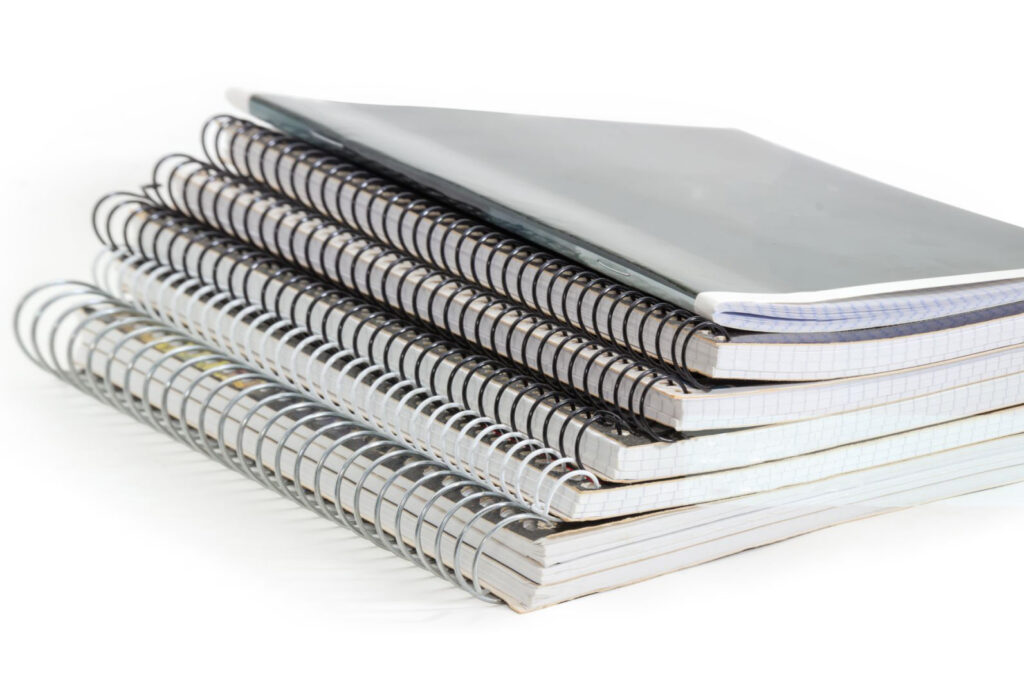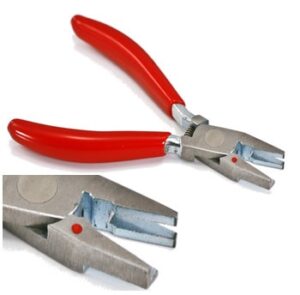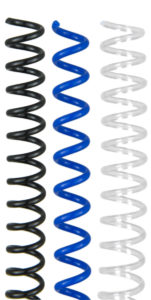
12 FAQ About the Spiral Coil Binding
Spiral binding, also known as coil binding or colour coil binding, is a popular document binding method that utilizes a flexible plastic coil to bind sheets of paper together. The coil is pre-formed into a spiral shape and inserted through a series of closely spaced holes along the edge of the document. The coil is then crimped at both ends to secure the pages in place. This binding method allows for easy 360-degree page rotation and provides a professional and polished finish to documents. Spiral coil binding is commonly used for a variety of applications, including presentations, reports, notebooks, manuals, and other documents where the ability to lay flat and the option for full rotation are desired. It is known for its durability, flexibility, and availability of coils in various colours to enhance visual appeal.
Explore this FAQ guide on the marvels of coil binding, offering valuable insights into considerations when investing in a spiral binding machine.
1. How is a spiral-bound book constructed?
Constructing a spiral-bound book involves a systematic process that begins with the preparation of pages, often through printing. The next step entails punching holes along the edge of the pages, with the number and spacing determined by the size of the book and the chosen spiral coil. The flexible plastic coil is then threaded through these holes, manually or with the assistance of a binding machine. Subsequently, the coil ends are crimped to secure the pages, any excess coil is trimmed, and a thorough quality check is conducted to ensure proper alignment and a defect-free binding. Optional steps may include adding a punched cover before or after the binding process and providing a finished and professional appearance to the spiral-bound book.
This meticulous construction results in a spiral-bound book known for its practicality, allowing for easy page-turning and a flat-open display. The durability of the plastic coil, the neat crimping of ends, and the option for colourful coils contribute to the overall appeal of spiral binding, making it a widely chosen method for various documents, from reports and manuals to notebooks and presentations.
2. Why is the coil longer than my book?
Spiral coils are 1″ longer than the intended binding edge length for easy cutting and crimping at each end.
3. What’s a coil crimper?
A coil crimper is a specialized tool designed for use in the spiral binding process, specifically for coil binding. Its primary function is to crimp or bend the ends of the plastic spiral coil after it has been threaded through the punched holes in the pages of a document. The crimping process secures the coil in place, preventing it from unravelling and ensuring the stability of the bound document.
Typically, a coil crimper has two components: a set of rollers and a crimper plier. The rollers help guide the coil into the desired position, and the crimper plier is used to crimp or deform the ends of the coil, effectively closing and securing the binding. This step is crucial for the overall integrity of the spiral-bound book, contributing to its professional appearance and durability.
Coil crimpers come in manual and electric variations, offering different levels of convenience and speed in the crimping process. They are an essential tool for anyone involved in the coil binding process, from small-scale office applications to larger-scale commercial binding operations.
4. What is the minimum and maximum page capacity for coil binding?
- Minimum Page Capacity: Coil binding can effectively bind documents with as few as 2 pages. However, extremely low page counts might present challenges during the binding process.
- Maximum Page Capacity: Coil binding is suitable for larger documents, and the maximum capacity can extend to several hundred pages, about 440 sheets (20 lb bond copy paper), or a 1 ¾” thick stack using the largest coil available, a 50mm.
5. What coil bind pitch do I need?
The coil bind pitch you need depends on the punching pattern of your binding machine. Coil bind pitch refers to the distance between the holes along the edge of the document. The two most common coil bind pitches are 4:1 pitch (four holes per inch) and 5:1 pitch (five holes per inch).
Here’s a brief guideline to help you choose the right coil bind pitch:
- 4:1 Pitch (0.250″):
- Suitable for larger documents with fewer holes per inch.
- Commonly used for documents with fewer pages, as it provides a larger hole pattern.
- 5:1 Pitch (0.200″):
- Ideal for smaller documents with more holes per inch.
- Suitable for documents with a higher page count, as the smaller hole pattern allows for more holes along the binding edge.
To determine the coil bind pitch you need, check the specifications of your coil binding machine or consult the manufacturer’s guidelines. Additionally, consider the size and thickness of your document, as well as your aesthetic preferences, as these factors can influence the choice of coil bind pitch.
6. How do I know what coil size I should get?
The most precise method for selecting the optimal coil size for your book involves placing all your pages on a desk, including covers and inserts, and measuring the thickness of the entire stack. Add 1/8″ to that measurement. Ensure that you measure the pages without applying pressure; let them lay loosely. Pressing down may result in a coil size that is too small, restricting the free turning of your pages.
7. What colour choices are available for the spiral binding coils?
We currently have 4 plastic coil colours: Black, Clear, Navy and White
8. Is it possible to coil bind without a machine?
Coil binding without a machine is possible, but by using a coil binding machine, the process becomes significantly more efficient and precise. Without a machine, the manual method involves threading the coil through the punched holes in the pages by hand, which can be time-consuming and may not yield consistently professional results. With a coil binding machine, the process is streamlined as it guides the coil through the punched holes and includes a built-in crimping feature to secure the ends of the coil seamlessly. While it’s feasible to coil bind manually, especially for smaller projects, investing in a coil binding machine ensures a smoother and more professional binding experience, particularly for larger or frequent binding tasks.
9. Can a coil-bound book have printing on its spine?
Printing on the spine of a coil-bound book is typically not feasible due to the nature of coil binding. The coil, which runs through the punched holes along the edge of the pages, obstructs the central portion of the spine. As a result, the space available for printing on the spine is limited.
10. Can the pages be easily replaced in a coil-bound book?
Yes, one of the advantages of coil binding is the ease with which pages can be replaced or added to a bound document.
This flexibility makes coil binding an excellent choice for documents that may require updates or changes over time, such as manuals, workbooks, or training materials. It eliminates the need to rebind the entire document, providing a cost-effective and efficient solution for document maintenance.
11. What types of books are Spiral Bound?
Spiral binding is commonly employed for a diverse range of books and documents. It is widely used for notebooks, journals, cookbooks, manuals, workbooks, and educational materials, where the ability to lay flat and the option for a full 360-degree rotation of pages are advantageous. Additionally, spiral binding is popular for presentations, reports, and business documents that benefit from a polished and professional finish.
12. Is coil binding better or worse than wire and comb?
The choice between coil binding, wire binding, and comb binding depends on specific preferences, needs, and the characteristics of the project. Each binding method has its own advantages and considerations:
- Coil Binding:
- Advantages: Allows for 360-degree page rotation, lays flat, is durable, and comes in various colours.
- Considerations: May not support as many pages as other methods, harder to print on the spine.
- Wire Binding:
- Advantages: Professional appearance, secure, suitable for larger documents.
- Considerations: Limited page rotation, not as easy to edit or add pages.
- Comb Binding:
- Advantages: Affordable, easy to edit or add pages, available in various colours.
- Considerations: Does not lay completely flat, less durable than coil or wire binding.
The “better” or “worse” designation depends on your specific priorities. If you value easy editing and a lay-flat feature, coil binding might be preferable.
Are you a business owner in search of reliable coil-binding machines to streamline your document-binding needs? Look no further. Discover the perfect coil binding solution for your organization today by exploring our range of top-quality machines. Contact us now to find the ideal coil binding machine that meets your specific requirements and witness the difference it can make for your business.










